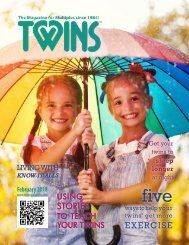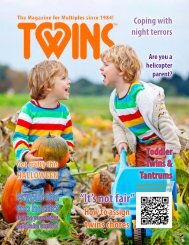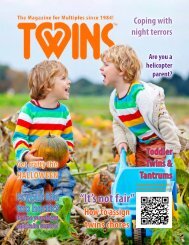Twins Magazine 2004 January February
Canadian family with four sets of twins sets Hardwired to Connect HMO forced to pay for TTTS surgery Holiday Survival Guide Oh my word! RSV season symptoms and strategies Sparkling Snowflakes The best-laid plans The hamster project Those “loving feelings” are hard to find Twins galore Two treatments help TTT babies Uh-oh! Toddler Trials and Training What causes monozygotic twinning Whining wears on single mom Help! I need somebody…
Canadian family with four sets of twins sets
Hardwired to Connect
HMO forced to pay for TTTS surgery
Holiday Survival Guide
Oh my word!
RSV season symptoms and strategies
Sparkling Snowflakes
The best-laid plans
The hamster project
Those “loving feelings” are hard to find
Twins galore
Two treatments help TTT babies
Uh-oh! Toddler Trials and Training
What causes monozygotic twinning
Whining wears on single mom
Help! I need somebody…
You also want an ePaper? Increase the reach of your titles
YUMPU automatically turns print PDFs into web optimized ePapers that Google loves.
growing stages
RSV season symptoms
and strategies
In most children and adults, Respiratory Syncytial Virus causes
a cold and goes away in a few days. For preemies, however,
RSV, especially in the first year of life, can be life-threatening.
School-aged siblings, exposure to tobacco smoke, male
gender, absence of breastfeeding, day care and a crowded
home increase the risk. If your babies show the more serious
symptoms of coughing, rapid or difficult breathing and
wheezing, call your doctor.
Washing your hands frequently is the most effective way to
protect your preemies. If they are not receiving injections of
the preventive medication Synagis, ask your pediatrician if
they would benefit from it.
For more information, visit www.rsvprotection.com,
www.preemiecare.com and www.mostonline.org.
Unlike singleton births, multiples
born to older moms fare the same or
better in birth than those born
to younger moms.
Nora and Emma, 23 months
The big 8
The eight most common food allergens cause more than
90% of all allergic reactions.
"Milk
"Eggs
"Fish
"Soy
"Shellfish
"Wheat
"Peanuts
"Tree nuts (walnuts, etc.)
New clues in SIDS mystery
High levels of immune protein in infant brain
In developed countries, SIDS remains the leading cause of death
in infants between 1 month and 1 year of age. The exact cause
of SIDS is unclear. According to a new study, elevated levels of
a brain protein may offer a clue.
Researchers who studied the brains of 27 infants—19 of
whom died from SIDS and eight from other conditions—
found a pattern of high levels of a protein called cytokine in
the SIDS brains.
Cytokines like interleukin-1 could be released in the body
in response to various stimuli under infectious or inflammatory
conditions and when there is a lack of oxygen. When
cytokines interact with neurotransmitters in the brain, the
result could change vital functions like arousal responses in
the central nervous system, thereby causing SIDS.
The study, however, has been criticized because
researchers haven’t agreed on what is a suitable control group
for SIDS babies and the SIDS and control infants in the study
were not age-matched. The cause of elevated cytokines also
remains unanswered. No studies have yet correlated the levels
of cytokines in the brain with those in peripheral blood in
SIDS infants.
Some experts believe a “triple-risk model” best explains
SIDS. The infant must have a vulnerability like sleep apnea or
low birth weight plus a trivial stressor such as a mild respiratory
infection or partial lack of oxygen. When these two factors
come together in an infant during a critical period of
development, usually between 3 and 8 months, SIDS can
occur, experts believe.
Dual command posts for breathing
Until recently, scientists believed that a single area in the brain
generated breathing rhythm, enabling breathing to speed up
or slow down to adapt to the body’s activity and position.
UCLA neurobiologists have discovered that two systems
in the brain interact to control breathing, a finding that may
lead to better treatment for sleep apnea and SIDS.
Understanding how the brain organizes breathing may shed
light on why babies stop breathing.
Myles Alexander and Brynn Renee'
34 JANUARY/FEBRUARY 2004 www.TwinsMagazine.com

















